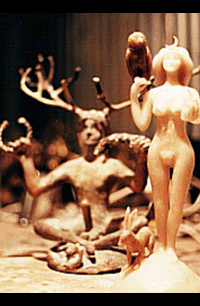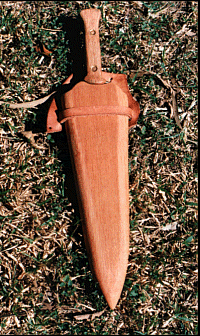 |
|||||
|
|
|||||
|
SH: I was born into a middle class trades background, the eldest of five children. My father, Eric Hawkins, was Australia's senior master sail-maker, by appointment to the Queen. He met the Royal Family on several occasions. My mother was a bookbinder and dressmaker and later in life studied under Denis Stewart and graduated with a diploma in homeopathy. Her family are of Highland Scottish descent and are reputed to possess the sight. They practised many traditional skills including herbalism and divination, and had access to familiar spirits. My mother was in the inner circle of the Aquarian Research Society in the late Sixties and studied with June Marsden, astrologer to the Queen Mother, and also with Fred Phillips, a high ranking Mason. She acted in co-operation with her familiars as a medium for June and Fred in their psychic archaeological research. She operated with a Celtic Qabalistical tradition but was never associated with the Craft. (I also studied with June for about a year at one stage, but she wasn't impressed with my Pagan tendencies.) S: The magic came mainly through the female line, then? SH: Male seership is also known to occur in Mum's family; one of my great uncles is also a seer, but he avoids any association with the occult. S: How did you make your way in the world prior to becoming a full-time craftsman? SH: After leaving school I joined the army and qualified as a radar mechanic. After military service I worked in the electronics industry before leaving the trade fifteen years ago. In 1983 I graduated from studies in iridology and Swedish and remedial massage and was in practice for two years in North Queensland. In 1989 I began studies for a diploma in fine art. It's significant that my published works from Kindred Spirits Quarterly and particularly Shadowplay were presented as my folio of work by TAFE and later James Cook University when I upgraded to a degree in visual arts. S: Well, that's the outer planes pretty well covered; what about the inner? SH: The most important religious influence during childhood came from my mother who was nominally Anglican but practised what she called "Celtic Christianity", a tradition she received from my great grandmother. Arthur was equated to Jesus and the Glastonbury Zodiac, embodying aspects of Arthur's exploits, was part of the Tradition and seems to pre-date Kathleen Maltwood's research. How this could come from the Scottish Highlands I haven't the slightest idea. My association with the Aquarian Research Society introduced me to Theosophy and I later adopted mainstream Hinduism in my late teens. I was on the verge of becoming a sanyasin when I found celibacy to be physically impossible. I moved on to Buddhism, then Taoism, but kept on hitting the celibacy barrier. Then I discovered Shamanism, at last a belief system I was capable of following. I was involved in Shamanism for four years and developed a natural ability for dream-state Shamanism. In 1983 a young woman wearing nothing but a piece of string around her waist explained to me the difference between Wicca and the craft of basket weaving! This put my Shamanic practices into a workable context and shed light on the Arthurian tradition I had inherited. I self-initiated in 1984. S: Since which time you've given a lot back to the community through your art. You also seem to be able to present a lot of information about the Craft to the world at large through your work. SH: It occurred to me that presenting the Pagan revival and Wicca as an artistic and cultural tradition is a very socially acceptable way of presenting ourselves. S: You've had a few shows of your work and work in progress. I think through your biggest splash on the Pagan community here has been the "Twenty-Two Images of the Tarot" bronze sculptures you exhibited at the 1992 Wiccan Festival.
As the piece was heated - to 1,100 C - the gas caused the mould to explode. It was just on dusk and the sight of molten bronze flying through the air was quite spectacular. The Blasted Tower had great gaping holes in it when divested of the mould, which embodied the image's concept so perfectly it wasn't possible to improve on it. The decision to exhibit the Tower as it was was the beginning of a more original outlook on the project. The next real challenge was Strength. I felt its image was irrelevant to the Southern Hemisphere Witch. The Sun in Leo - at Midwinter? I decided to substitute a pair of altar figures as being more relevant than the Sun at Yule. The basic design is Rhea's, an illustration published in Shadowplay #23, but when the first clay models were made there was an obvious imbalance of power. The Horned God was very phallic, but the Goddess was very demure, inhibited. They both had either to be turned on or turned off and, well, who wants a floppy Horned God? So the Goddess piece became very much the exhibitionist, the Sheila na Gig, no compromises. S: Your next collection "Art Beyond Price" also features a pretty stunning Sheila na Gig as its central image. SH: A series of dreams came to me in which a woman featured prominently and erotically. I'd been meditation on the Goddess as Sheila na Gig, and this woman's image really inspired me. The piece was cast in bronze and was being finished when, while visiting a friend, I met the very woman I'd dreamed of. The mutual recognition was instant; she even mentioned "disturbing" dreams around the time of my dreamings! She's quite a nice lady - we've worked together several times - but very private. If I did anything that might identify her, I'd spend the rest of this life as a toad. S: What projects have come along since then?
I've developed a small charcoal furnace capable of melting 100g of bronze which I mix to the traditional Irish formula, melting 90g of copper, then adding 10g of tin. The copper is recycled electrical wire but pure tin isn't available as scrap so I buy small ingots of tin. I don't use scrap bronze as it usually contains zinc which stops knife blades and the like hardening properly. The research into ancient bronze casting techniques has provided the artistic basis for the project. The moulds I use are terra cotta piece moulds, the same as used by the beaker people. If they're made right, they're reusable - a fact that appears to be unknown to sculptors, founders and archaeologists. S: You've finished your courses now; what plans for the future? SH: It's off to the New Age and folk festivals to do some performance pieces. Basically I'll be setting up my portable furnace and doing exhibition casting on site. There's nothing like a roaring furnace and the sound of hammer and anvil to draw a crowd, then I'll sell the knives and swords I've made prior to the festival as well as those made during the performance. S: I don't think you'll have trouble finding a market somehow. SH: Well, I did a bit of market research with some of the local Witches a while back. I'd been making bronze knives with wooden handles riveted on and pouches for them with a gemstone and bell. They presented well. So I made a presentation to gauge product viability and show them around to a group of mainly women. There'd invariably ba a couple of women desperately clutching particular knives with glazed looks in their eyes. At that point I'd pack the other knives up and explain that every time I show the knives around there's always a couple of them who choose themselves a Witch to look after and go off and live a life of their own, in which case I wouldn't dream of selling them. Putting money into the equation upsets the magical context.
|
|||||
|
Published in Australia 1984 - 1990 - In Seattle & Sydney 1990-1994 Sydney/Seattle Webzine 2000 WebDesign: Rhea - Page last updated 10 July 2001 Copyright Shadowplay 2000. All Rights Reserved. |
|||||


